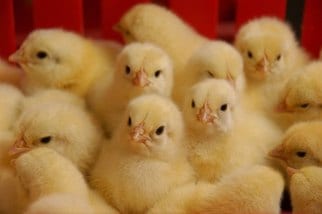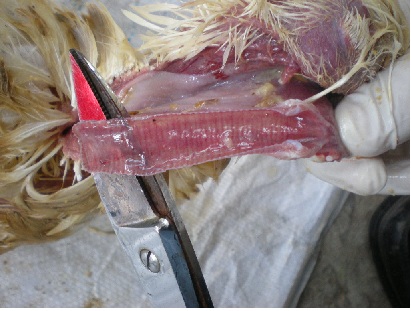画像 e coli symptoms in poultry 493815-E.coli infection in poultry pdf
Signs and symptoms of E coli O157H7 infection usually begin three or four days after exposure to the bacteria But you may become ill as soon as one day after exposure to more than a week later Signs and symptoms include Diarrhea, which may range from mild and watery to severe and bloody Stomach cramping, pain or tendernessEnteritis is inflammation or swelling of the intestines One of the most common causes of enteritis is the bacterium Escherichia coli, or E coliThis bacterium is theGangrenous dermatitis is observed, particularly in immunocompromised chickens, affected by infectious bursal disease or chicken anemia virus infection Gangrenous dermatitis is often due to a combination of S aureus and Clostridium septicum and/or Escherichia coli Affected areas are usually hemorrhagic and crepitant

E Coli In Poultry What Is It Val Co
E.coli infection in poultry pdf
E.coli infection in poultry pdf-In fact, the symptoms that E coli can cause are essentially the same as those caused by salmonella (paratyphoid) I often become suspicious of E coli when I start to see various symptoms arise in a persons loft The symptoms include Enteritis This is the most common of the problems associated with E coli and simply is loose droppingsLow pathogenic Avian Influenza(LPAI) in Poultry;



Chronic Respiratory Disease Crd And Crd Combined With Ecoli In Poultry Technical Information Bio Pharmachemie
E coli causing extraintestinal diseases (extraintestinal pathogenic E coli, ExPEC) is one of the major sources of sepsis/ bacteraemia in humans and many animals Avian pathogenic E coli (APEC) represent a subgroup of ExPEC and cause colibacillosis Colibacillosis in poultry Colibacillosis was first described in chickens in 14According to the National Kidney Foundation, 80 to 90 percent of UTIs are caused by a bacteria called Escherichia coli For the most part, E coli lives harmlessly in your gut But it can causeColibacillosis or Escherichia coli (E coli) infections in eggtype chickens continues as one of the top five disease issues in pullets and layers, it's prevalence and significance of losses has declined The Disease E coli infections show up in flocks in five different syndromes or stages of life;
Low Pathogenic Avian Influenza (H9N2)What Is E coli Enteritis?Growel Agrovet Private Limited Offering Poultry CRD & EColi Medicine, 1 Ltr 500 Ml, Packaging Type 1 Ktr 500 Ml at Rs 500/bottle in Bengaluru, Karnataka Read about company Get contact details and address ID
E coli Symptoms Birds may show ruffled feathers as a symptom of an E coli infection Signs are nonspecific and vary with age, organs involved, and concurrent diseases Signs may include listlessness, ruffled feathers, depression, decreased appetite, cough, and labored breathingAs E coli is transmitted vertically from breeders to their offspring, prophylactic measures should include the reduction of disease carrying Ecoli in the higher levels of the production pyramid The recommendations follow a ProHealth study into E coli infections in broiler production, which found that infectious causes of mortality were documented in more than half the dead breedersSigns in poultry Poultry naturally have E coli in their gut, and don't usually show signs of illness Even if they look healthy and clean, poultry can still spread the bacteria to people Symptoms in people Symptoms depend on the kind of E coli causing the infection


Www Ajol Info Index Php Sokjvs Article View 1518


E Coli Or Colibacillosis Infections In Poultry Pashudhan Praharee
E coli (Escherichia coli), is a type of bacteria that normally lives in your intestinesIt's also found in the gut of some animals Most types of E coli are harmless and even help keep yourEcoli Symptoms and Prevention in Poultry Escherichia Coli Infection Popularly Known as E Coli infections are commonly triggered by Immune suppression or by Symptoms Symptoms may vary , depending on the severity of disease and environment But some symptoms of EColi are PreventionColibacillosis is caused by bacterial infection with avian pathogenic Escherichia coli (APEC) and is found in poultry flocks worldwideEcoli is a gramnegative, rodshaped bacterium which is normally found in the intestine of poultry and most other animals Although most serotypes are nonpathogenic, a limited number produce extra intestinal infections



Escherichia Coli Infections Diseases Of Poultry The Poultry Site The Poultry Site


Manual On Meat Inspection For Developing Countries
Chickens can be infected with a low pathogenic E coli which may go undetected for a long time The usual signs are decreased performance (decreased egg laying), lethargy, diarrhea and generally looking ill E coli is shed in the poop, so infection of other birds can easily occurE coli O157H7 is the most important STEC serotype in relation to public health;A study in 17 found two in three fresh chickens sold in the UK is infected with Ecoli However, the strain of the bacteria found in the meat is not dangerous to your health



E Coli Infections Peritonitis In Layers Dutchland Farms



A Poultrykeeper S Guide To Spotting And Controlling Blackhead Farmers Weekly
E coli was found in about 80 percent of the nearly 2,500 meat samples and in 72 percent of the urine and blood samples from patients who tested positive for infection, the study authors said EAvian pathogenic Escherichia coli (APEC) cause aerosacculitis, polyserositis, septicemia and other mainly extraintestinal diseases in chickens, turkeys and other avian species APEC are found in the intestinal microflora of healthy birds and most of the diseases associated with them are secondary to environmental and host predisposing factorsPoultry diseases symptoms and treatments This is the case for E coli infections, nutritional deficiencies and internal parasites Such diseases rarely kill the individual bird, but have a remarkable effect on the immune system of the birds, thus creating the basis for easy infection by other diseases


Www Ajol Info Index Php Sokjvs Article View 1518



Colibacillosis Microbewiki
Poultry diseases symptoms and treatments This is the case for E coli infections, nutritional deficiencies and internal parasites Such diseases rarely kill the individual bird, but have a remarkable effect on the immune system of the birds, thus creating the basis for easy infection by other diseasesPoultry Diseases Menu Toggle Viral diseases Menu Toggle Avian Influnza Menu Toggle Can You Really Find WHAT IS BIRDS FLU;Ameliorating effect of Withania somnifera root extract in Escherichia coliinfected broilers Poultry science vol 99,4 () Tarazi, Yaser Hamadeh et al In vitro and in vivo efficacy study of cefepime, doripenem, tigecycline, and tetracycline against extendedspectrum betalactamases Escherichia coli in chickens Veterinary world vol 13,3 ()



Nadis National Animal Disease Information Service



How Much Is E Coli Costing Your Layer Operation Wattagnet


コメント
コメントを投稿